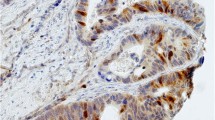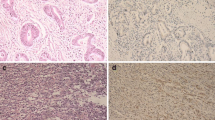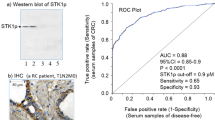Abstract
Colorectal carcinoma (CRC) is a heterogeneous disease with specific epidemiological, pathological, molecular, and clinical characteristics that depend on the location of the tumor relative to the splenic flexure. Thymidylate synthase (TS) is a major target of 5-fluorouracil-based chemotherapy for CRC and high expression of this enzyme in tumor cells can influence the effect of therapy. We examined differences in TS protein expression in nuclei of tumor cells between CRCs located proximal and distal to the splenic flexure. Nuclear TS was detected by immunohistochemistry with a TS 106 monoclonal antibody on tissue microarrays constructed from 269 CRCs. The median histological score of nuclear TS expression of all proximal tumors was two times higher (p = 0.0003) and in men three times higher (p = 0.00023) than that found in distal tumors. In multivariate analysis which included age, sex, Astler–Coller stage, histological grade, and site, only proximal location of the tumor was identified as an independent factor associated with higher TS expression (odds ratio 2.46, 95% confidence interval = 1.29–4.70, p = 0.0062). These results demonstrate significant differences in nuclear TS expression between proximal and distal cancers and suggest the potential importance of the site of the tumor for proper stratification of patients for chemotherapy.



Similar content being viewed by others
References
Azzoni C, Bottarelli L, Campanini N et al (2007) Distinct molecular patterns based on proximal and distal sporadic colorectal cancer: arguments for different mechanisms in the tumorigenesis. Int J Colorectal Dis 22:115–126
Gervaz P, Bucher P, Morel P (2004) Two colons-two cancers: paradigm shift and clinical implications. J Surg Oncol 88:261–266
Thibodeau SN, Bren G, Schaid D (1993) Microsatellite instability in cancer of the proximal colon. Science 260:816–819
S-Ch C, Lin J, Yang S, Wand H-S et al (2006) Relationship between genetic alterations and prognosis in sporadic colorectal cancer. Int J Cancer 118:1721–1727
van Triest B, Peters GJ (1999) Thymidylate synthase: a target for combination therapy and determinant of chemotherapeutic response in colorectal cancer. Oncology 57:179–194
Allegra C, Sargent D (2003) Molecular diagnostics: assays, tissues, progress, and pitfalls. J Clin Oncol 21:395–396
van Triest B, Pinedo HM, van Hensbergen Y et al (1999) Thymidylate synthase level as main predictive parameter for sensitivity to 5-fluorouracil but not for folate-based thymidylate synthase inhibitors in 13 nonselected colon cancer cell lines. Clin Cancer Res 5:643–654
Ichikawa W, Uetake H, Shirota Y et al (2003) Combination of dihydropyrimidine dehydrogenase and thymidylate synthase gene expressions in primary tumors as predictive parameters for the efficacy of fluoropyrimidine-based chemotherapy for metastatic colorectal cancer. Clin Cancer Res 9:786–791
Etienne MC, Chazal M, Laurent-Puig P et al (2002) Prognostic value of tumoral thymidylate synthase and p53 in metastatic colorectal cancer patients receiving fluorouracil-based chemotherapy: phenotypic and genotypic analyses. J Clin Oncol 20:2832–2843
Wong NACS, Brett L, Stewart M et al (2001) Nuclear thymidylate synthase expression, p53 expression and 5FU response in colorectal carcinoma. Br J Cancer 85:1937–1943
Kornmann M, Schwabe W, Sander S et al (2003) Thymidylate synthase and dihydropyrimidine dehydrogenase mRNA expression levels: predictors for survival in colorectal cancer receiving adjuvant chemotherapy. Clin Cancer Res 9:4116–4124
Edler D, Glimelius B, Hallström M et al (2002) Thymidylate synthase expression in colorectal cancer: a prognostic and predictive marker of benefit from adjuvant fluorouracil based chemotherapy. J Clin Oncol 20:1721–1728
Popat S, Matakidou A, Houlston RS (2004) Thymidylate synthase expression and prognosis in colorectal cancer: a systematic review and meta-analysis. J Clin Oncol 22:529–536
Fernandes-Contreras M-E, Jimenez de Ayala B, Garcia de Paredes M-L et al (2004) Thymidylate synthase expression pattern is a prognostic factor in patients of colorectal cancer treated with 5-fluorouracil. Inter J Oncol 25:877–885
Edler D, Kressner U, Ragnhammar P et al (2000) Immunohistochemically detected thymidylate synthase in colorectal cancer: an independent prognostic factor of survival. Clin Cancer Res 6:488–492
Kamoshida S, Matsuoka H, Ishikawa T et al (2004) Immunohistochemical evaluation of thymidylate synthase (TS) and p16INK4a in advanced colorectal cancer: implication of TS expression in FU-based adjuvant chemotherapy. Jpn J Clin Oncol 34:594–601
Popat S, Chen Z, Zhao D et al (2006) A prospective, blinded analysis of thymidylate synthase and p53 expression as prognostic markers in the adjuvant treatment of colorectal cancer. Ann Oncol 17:810–817
Jensen SA, Vainer B, Sørensen JB (2006) The prognostic significance of thymidylate synthase and dihydropyrimidine dehydrogenase in colorectal cancer of 303 patients adjuvantly treated with 5-fluorouracil. Int J Cancer 120:694–701
Broll R, Busch P, Duchrow M et al (2005) Influence of thymidylate synthase and p53 protein expression on clinical outcome in patients with colorectal cancer. Int J Colorectal Dis 20:94–102
Tomiak A, Vincent M, Earle CC et al (2001) Thymidylate synthase expression in stage II and III colon cancer. Am J Clin Oncol 24:597–602
Ciaparrone M, Quirino M, Schinzari G et al (2006) Predictive role of thymidylate synthase, dihydropyrimidine dehydrogenase and thymidine phosphorylase expression in colorectal cancer patients receiving adjuvant 5-fluorouracil. Oncology 70:366–377
Elsaleh H, Joseph D, Grieu F et al (2000) Association of tumor site and sex with survival benefit from adjuvant chemotherapy in colorectal cancer. Lancet 355:1745–1750
Bissoon-Haqqani S, Moyana T, Jonker D et al (2006) Nuclear expression of thymidylate synthase in colorectal cancer cell lines and clinical samples. J Histochem Cytochem 54:19–20
Johnston PG, Liang C-H, Henry S et al (1991) Production and characterization of monoclonal antibodies that localize human thymidylate synthase in the cytoplasm of human cells and tissue. Cancer Res 51:6668–6676
Ricciardiello L, Ceccarelli C, Angiolini G et al (2005) High thymidylate synthase expression in colorectal cancer with microsatellite instability: implications for chemotherapeutic strategies. Clin Cancer Res 11:4234–4240
Chung GG, Kielhorn EP, Rimm DL (2002) Subjective differences in outcome are seen as a function of the immunohistochemical method used on a colorectal cancer tissue microarray. Clin Colorectal Cancer 1:237–242
Jakob C, Liersch T, Meyer W et al (2005) Immunohistochemical analysis of thymidylate synthase, thymidine phosphorylase, and dihydropyrimidine dehydrogenase in rectal cancer (cUICC II/III). Correlation with histopathologic tumor regression after 5-fluorouracil-based long-term neoadjuvant chemoradiotherapy. Am J Surg Pathol 29:1304–1309
Detre S, Saccani Jotti G, Dowsett M (1995) A “quickscore” method for immunohistochemical semiquantitation: validation for oestrogen receptor in breast carcinomas. J Clin Pathol 48:876–878
Kirkegaard T, Edwards J, Tovey S et al (2006) Observer variation in immunohistochemical analysis of protein expression, time for a change? Histopathology 48:787–794
Lenz HJ, Danenberg KD, Leichman CG et al (1998) p53 and thymidylate synthase expression in untreated stage II colon cancer: associations with recurrence, survival and site. Clin Cancer Res 4:1227–1234
Sanguedolce R, Vultaggio G, Sanguedolce F et al (1998) The role of thymidylate synthase levels in the prognosis and the treatment of patients with colorectal cancer. Anticancer Res 18:1515–1520
Samsonoff W, Reston J, McKee M et al (1997) Intracellular location of thymidylate synthase and its state of phosphorylation. J Biol Chem 20:13281–13285
Santini D, Vincenzi B, Perrone G et al (2004) Thymidylate synthase expression in normal colonic mucosa: a predictive marker of toxicity in colorectal cancer patients receiving 5-fluorouracil-based adjuvant chemotherapy. Oncology 67:135–142
Gonen M, Hummer A, Zervoudakis A et al (2003) Thymidylate synthase expression in hepatic tumors is a predictor of survival and progression in patients with resectable metastatic colorectal cancer. J Clin Oncol 21:406–412
Bufill JA (1990) Colorectal cancer: evidence for distinct genetic categories based on proximal or distal tumor location. Ann Intern Med 113:779–788
Liu LU, Holt PR, Krivosheyev V et al (1999) Human right and left colon differ in epithelial cell apoptosis and in expression of Bak, a pro-apoptotic Bcl-2 homologue. Gut 45:45–50
Wiencke JK, Zheng S, Lafuente A et al (1999) Aberrant methylation of p16INK4a in anatomic and gender-specific subtypes of sporadic colorectal cancer. Cancer Epidermiol Biomarkers Prev 8:501–506
Rijnsoever M, Elsaleh H, Joseph D et al (2003) CpG island methylator phenotype is an independent predictor of survival benefit from 5-fluorouracil in stage III colorectal cancer. Clin Cancer Res 9:2898–2903
Kim GP, Colangelo LH, Wicand HS et al (2007) Prognostic and predictive roles of high-degree microsatellite instability in colon cancer: a National Cancer Institute-National Surgical Adjuvant Breast and Bowel Project Collaborative Study. J Clin Oncol 25:767–772
Sinicrope FA, Rego RL, Halling KC et al (2006) Thymidylate synthase expression in colon carcinomas with microsatellite instability. Clin Cancer Res 12:2738–2744
Popat S, Wort R, Houlston RS (2005) Relationship between thymidylate synthase (TS) genotype and TS expression: a tissue microarray analysis of colorectal cancers. Int J Surg Pathol 13:127–133
Acknowledgement
This study was supported by a grant (KBN 2P05B 174 28) from the Polish Committee for Scientific Research.
Disclosure/conflict of interest
All authors declare that they have no conflict of interest to disclose.
Author information
Authors and Affiliations
Corresponding author
Rights and permissions
About this article
Cite this article
Sulzyc-Bielicka, V., Domagala, P., Majdanik, E. et al. Nuclear thymidylate synthase expression in sporadic colorectal cancer depends on the site of the tumor. Virchows Arch 454, 695–702 (2009). https://doi.org/10.1007/s00428-009-0787-x
Received:
Revised:
Accepted:
Published:
Issue Date:
DOI: https://doi.org/10.1007/s00428-009-0787-x




